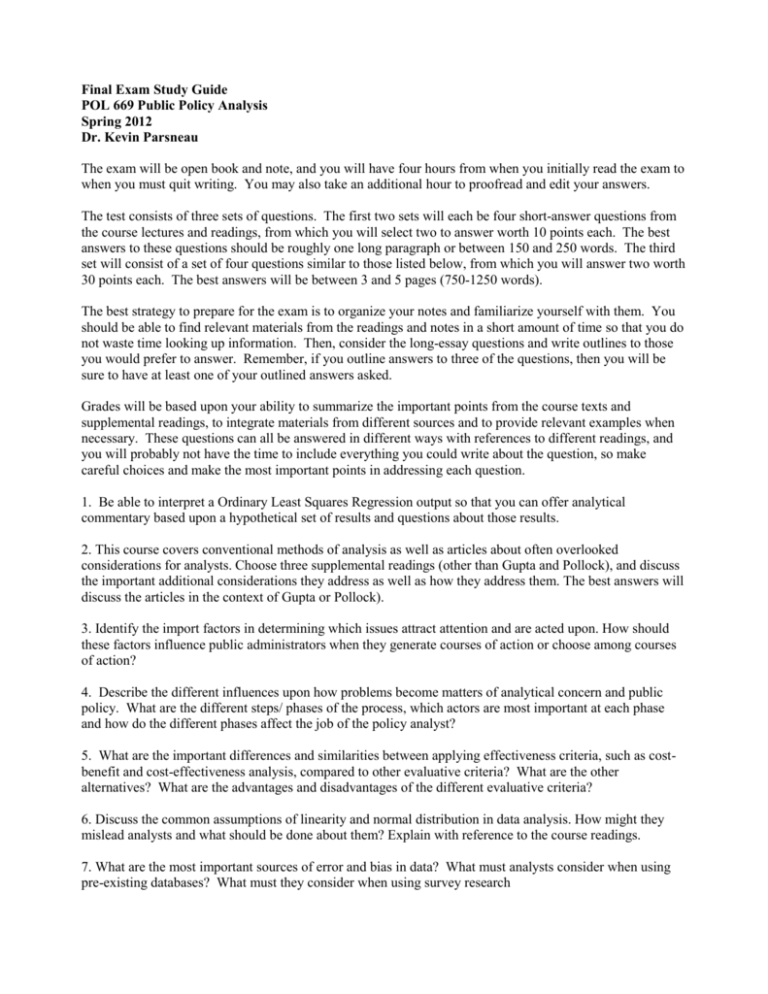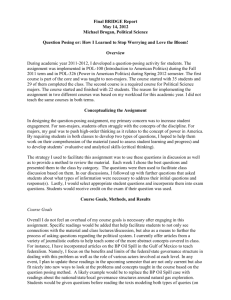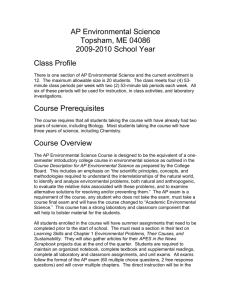Final Exam Study Guide POL 669 Public Policy Analysis Spring
advertisement

Final Exam Study Guide POL 669 Public Policy Analysis Spring 2012 Dr. Kevin Parsneau The exam will be open book and note, and you will have four hours from when you initially read the exam to when you must quit writing. You may also take an additional hour to proofread and edit your answers. The test consists of three sets of questions. The first two sets will each be four short-answer questions from the course lectures and readings, from which you will select two to answer worth 10 points each. The best answers to these questions should be roughly one long paragraph or between 150 and 250 words. The third set will consist of a set of four questions similar to those listed below, from which you will answer two worth 30 points each. The best answers will be between 3 and 5 pages (750-1250 words). The best strategy to prepare for the exam is to organize your notes and familiarize yourself with them. You should be able to find relevant materials from the readings and notes in a short amount of time so that you do not waste time looking up information. Then, consider the long-essay questions and write outlines to those you would prefer to answer. Remember, if you outline answers to three of the questions, then you will be sure to have at least one of your outlined answers asked. Grades will be based upon your ability to summarize the important points from the course texts and supplemental readings, to integrate materials from different sources and to provide relevant examples when necessary. These questions can all be answered in different ways with references to different readings, and you will probably not have the time to include everything you could write about the question, so make careful choices and make the most important points in addressing each question. 1. Be able to interpret a Ordinary Least Squares Regression output so that you can offer analytical commentary based upon a hypothetical set of results and questions about those results. 2. This course covers conventional methods of analysis as well as articles about often overlooked considerations for analysts. Choose three supplemental readings (other than Gupta and Pollock), and discuss the important additional considerations they address as well as how they address them. The best answers will discuss the articles in the context of Gupta or Pollock). 3. Identify the import factors in determining which issues attract attention and are acted upon. How should these factors influence public administrators when they generate courses of action or choose among courses of action? 4. Describe the different influences upon how problems become matters of analytical concern and public policy. What are the different steps/ phases of the process, which actors are most important at each phase and how do the different phases affect the job of the policy analyst? 5. What are the important differences and similarities between applying effectiveness criteria, such as costbenefit and cost-effectiveness analysis, compared to other evaluative criteria? What are the other alternatives? What are the advantages and disadvantages of the different evaluative criteria? 6. Discuss the common assumptions of linearity and normal distribution in data analysis. How might they mislead analysts and what should be done about them? Explain with reference to the course readings. 7. What are the most important sources of error and bias in data? What must analysts consider when using pre-existing databases? What must they consider when using survey research











